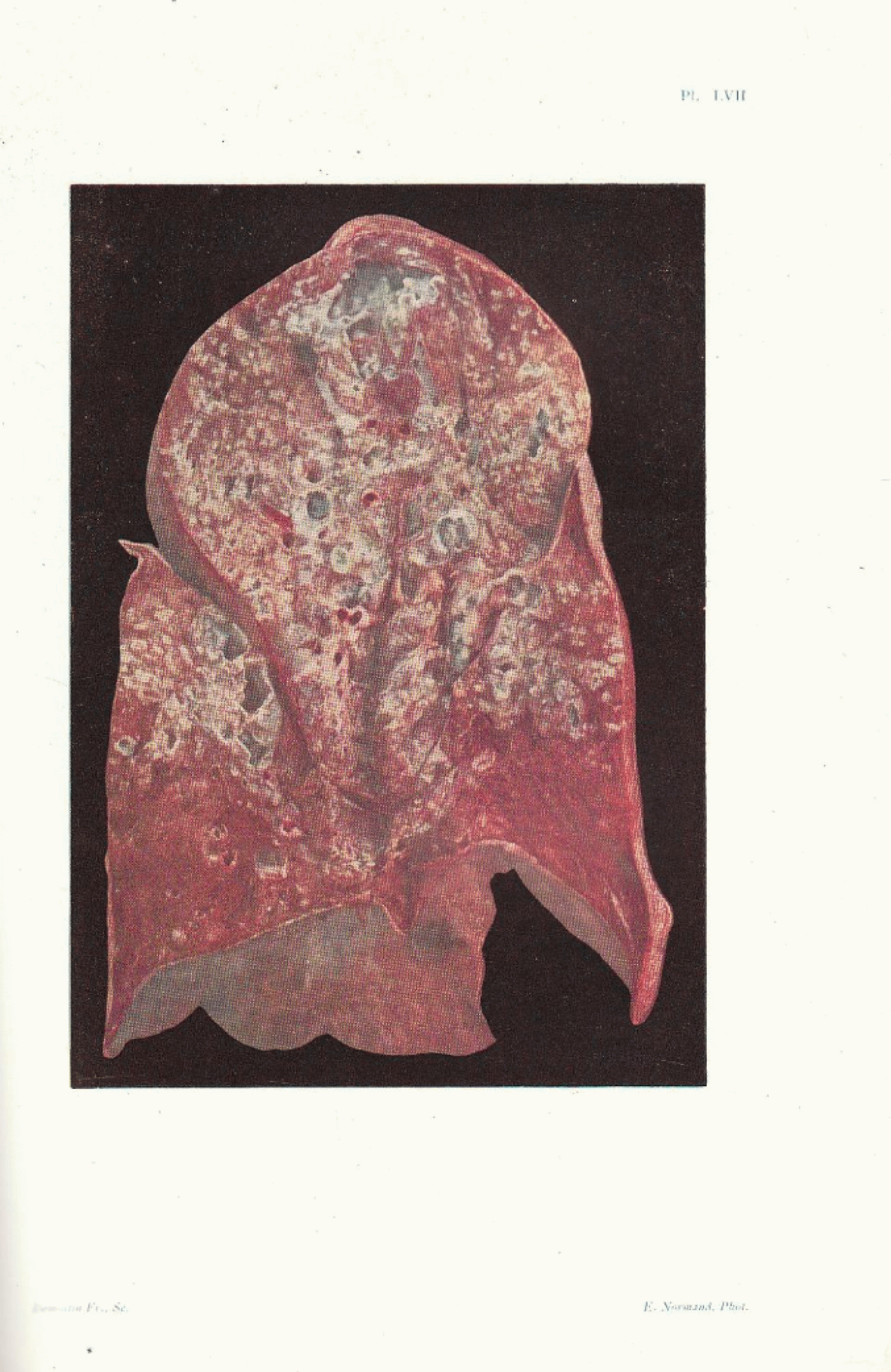Ciclo di conferenze
Caroline Fuchs:
Direkt nach der Natur. Zur Verwendung des Autochroms als Bildmedium der Wissenschaften und Wissensvermittlung
Within the framework of the Lecture Series Phenomenon ‘Colour’. Aesthetics – Epistemology – Politics

Tafel LVII aus: Maurice Letulle: La Tuberculose pleuro-pulmonaire, Paris 1917.
Im Jahr 1907 wurde mit der Veröffentlichung des Autochroms der Brüder Lumière ein Farbfotografie-Verfahren verfügbar, das als das erfolgreichste Einplattenverfahren des frühen 20. Jahrhunderts gilt. Es lieferte leuchtende Farben und konnte fertig gekauft ohne vorbereitende Schritte in gängigen Fotoapparaten verwendet werden. Seine Verbreitung litt jedoch an der Einschränkung, dass es Glasplattenpositive lieferte, die nur mit Qualitätsverlusten reproduziert werden konnten.
Zeitgenossen feierten das Autochrom euphorisch als Durchbruch der Farbfotografie und als zukünftiges Bildmedium der Wahl für die Wissenschaft. Diese Vorhersage sollte sich, wie ähnliche Voraussagen die 1839 zu den monochromen Verfahren getroffen wurden, nicht erfüllen. Dennoch wurde das Autochrom in bestimmten Bereichen der Wissenschaft und Wissensvermittlung genutzt, teilweise auch mit großem Erfolg. Der Vortrag stellt einzelne Beispiele einer solchen Verwendung vor und diskutiert, in welcher Weise das Autochrom hier eingesetzt wurde und wie die fotografische Farbaufzeichnung in dieser frühen Verwendung präsentiert und kommentiert wurde.
Caroline Fuchs studierte Kunstgeschichte und Klassische Archäologie in Tübingen, Manchester und Berlin. Von 2009 bis 2013 war sie Universitätsassistentin und Leiterin des Labors für empirische Bildwissenschaften am Institut für Kunstgeschichte der Universität Wien. 2014 wurde sie an der Humboldt-Universität zu Berlin mit einer Arbeit über Autochromfotografie in Großbritannien promoviert (2017 bei DeGruyter erschienen unter dem Titel Das Autochrom in Großbritannien. Revolution der Farbfotografie), die durch Stipendien des Paul Mellon Centre for Studies in British Art und der Huntington Library unterstützt worden war. Seit 2017 ist sie Konservatorin an der Neuen Sammlung – The Design Museum und dort seit 2019 Referentin der Sammlung Grafik Design.
The lecture will take place online via Zoom. The event is free, but it is necessary to register. Please register at the following address: https://zoom.us/meeting/register/tJwkfuChrz8vG9TwugyYKzz0nG3Zli3HkNmB
This talk is part of the Lecture Series "Phenomenon ‘Colour’. Aesthetics – Epistemology – Politics" (Franziska Lampe/ZI Munich and Katharine Stahlbuhk/BH Rome).
The preoccupation with colour, which in many cultures plays a fundamental role in artistic practice, art history, and art theory, is driven and at the same time complicated by the fact that colour as an optically mediated sensory impression is always determined by subjective factors, such as the respective condition of the perceptual apparatus. However, colour (and its perception) is also dependent on a variety of external physical conditions and is decisively shaped by social and cultural preconditions, as well as linguistic meanings and attributions. Seeing and talking about colour – one of the fundamental tasks of art historians – therefore proves to be a complex process that does not only touch on perceptivity, but is also closely connected to aesthetic, epistemic, ethical and (power-)political questions and problems, and is not least accompanied by (pre-)judgements. This ambiguity – even indeterminacy – of the phenomenon ‘colour’ is a good starting point to grapple with its sometimes divergent characterisations and to question historically rooted attributions and contentious categorisations.
The aim of the lecture series “Phenomenon ‘Colour’. Aesthetics – Epistemology – Politics” is thus to take a critical look at the hierarchies and ideologies associated with colour and to examine what consequences result from the colour schemes, theories and harmonies often determined in the West. The spectrum of questions is broad and may touch upon the following thematic areas: How do we in art history deal with the linguistic limits of describing the phenomenon of colour? How can we talk about colours today, aware of their historical and cultural imprints? How and when do the semantics associated with individual colours change over time? To what extent are colour metaphors and symbolisms instrumentalised nowadays? And as a result: what ethical implications are attributed to certain colours? How and in what form is colour or the lack of it ideologically used and abused? And what are the (power-political) dispositifs in which judgements about colours are made? Or, more fundamentally, why does colour affect us so profoundly?
The lecture series is an additional platform for a critical exchange on the “Phenomenon ‘Colour’”, which will be the subject of a special edition of the journal "kritische berichte" published in spring 2022.
30 novembre 2021, ore 17:00
This event will take place online.
To participate please register in advance via Zoom: https://zoom.us/meeting/register/tJwkfuChrz8vG9TwugyYKzz0nG3Zli3HkNmB
Avviso
Questo evento viene documentato fotograficamente e/o attraverso riprese video. Qualora non dovesse essere d’accordo con l’utilizzo di immagini in cui potrebbe essere riconoscibile, da parte del Kunsthistorisches Institut in Florenz a scopo di documentazione degli eventi e di pubbliche relazioni (p.e. social media) la preghiamo gentilmente di comunicarcelo.


